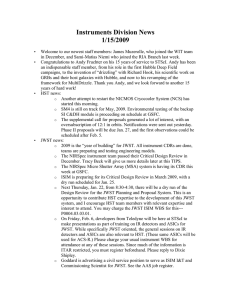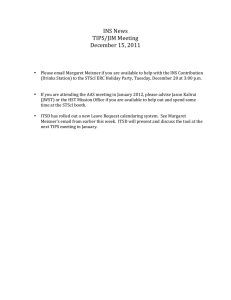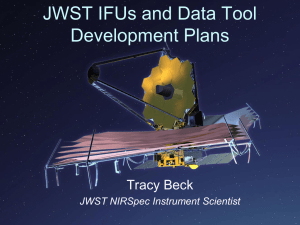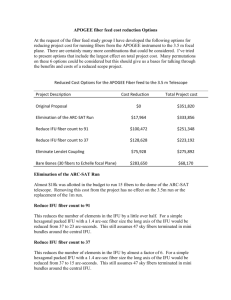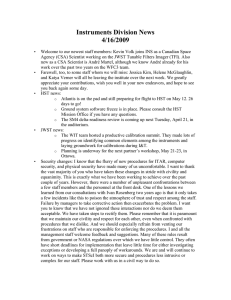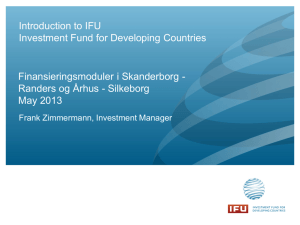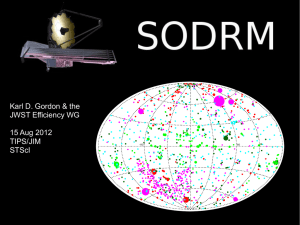TIPS/JIM December 16, 2010
advertisement
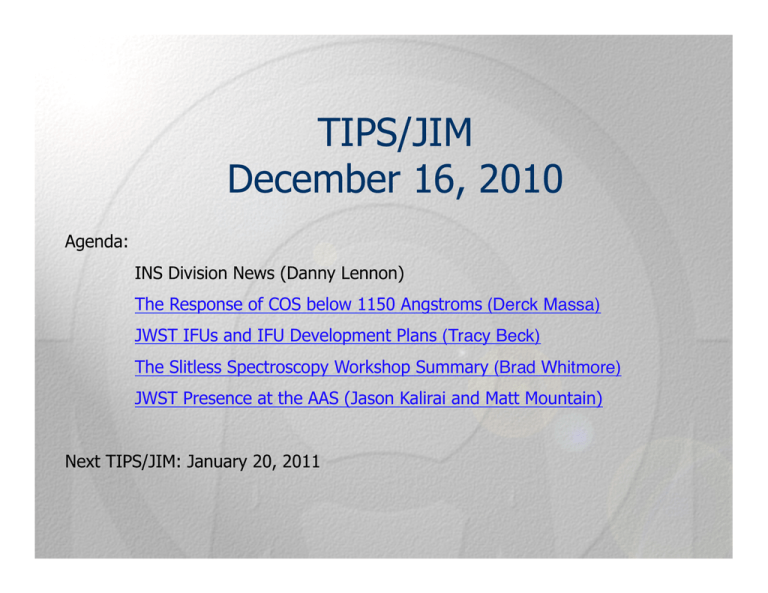
TIPS/JIM December 16, 2010 Agenda: INS Division News (Danny Lennon) The Response of COS below 1150 Angstroms (Derck Massa)! JWST IFUs and IFU Development Plans (Tracy Beck)! The Slitless Spectroscopy Workshop Summary (Brad Whitmore)! JWST Presence at the AAS (Jason Kalirai and Matt Mountain) Next TIPS/JIM: January 20, 2011 INS Status TIPS/JIM Meeting December 16, 2011 First of all, Happy Forthcoming Holidays. Thanks to all the INS staff for ensuring our contribution to the Institute's holiday party was a great success. In particular we should thank the organizing team: Pey Lian Lim (our coordinator), Amber Armstrong, Elizabeth Barker, Ralph Bohlin, Van Dixon, Brian Ferguson, Harry Ferguson, Norman Grogin, Diane Karakla, Danny Lennon, Chris Long, Ray Lucas, Margaret Meixner, Sarah Ogaz, Marshall Perrin, Paule Sonnentrucker, Mike Wolfe, Loretta Willers, Doug Long, Bill Blair, Justin Ely JWST -------The Casani report on JWST is out and has been discussed in the press. Refer to the presentation by Matt Mountain for its implications. Jason Kalirai will discuss how we can present JWST at the forthcoming AAS meeting. Jason will also organize a special meeting of AAS attendees for a more detailed discussion. Interested parties should contact him. TIPS/JIM December 16, 2010 Agenda: INS Division News (Danny Lennon) The Response of COS below 1150 Angstroms (Derck Massa)! JWST IFUs and IFU Development Plans (Tracy Beck)! The Slitless Spectroscopy Workshop Summary (Brad Whitmore)! JWST Presence at the AAS (Jason Kalirai and Matt Mountain) Next TIPS/JIM: January 20, 2011 The response of COS below 1150 Angstroms (The new cycle 19 settings) The COS team, the IDT (esp, S. Osterman, S. Penton and S. Beland), S. McCandliss (JHU) and P. Chayer (STScI/CSA) Background: • • • • • MgF2 has very low transmission below 1150 Å HST OTA has MgF2 coatings STIS MAMA window is MgF2 = thousands of reflections COS FUV gratings have MgF2 coatings But, COS FUV has only one bounce and windowless detectors • Expected to have some FUV response • First seen in SMOV -- McCandliss et al. (2010) Two cal programs explored COS FUV: • 12081 to establish FUV (and more?) G140L response • 12082 to explore G130M FUV response. The G140L -- A rock and a hard place GD50 G130M Resolution Problems -- Challenges • New settings use FUVB only -- no wavecal • Cannot use the BOA -- it has a MgF2 substrate, and does not transmit below 1150Å. • Resolution of the G140L and G130M are comparable in the FUV. • G140L has complete coverage, but must contend with the shoulder in the response curve. • G130M avoids the shoulder, but need two settings for complete coverage • There may be some (~1cm2) EUV response. Summary Mode Range Aeff R G140L/1280 920-1160Å 10-20 cm2 2100 G130M/1096 1040-1081Å 15-25 cm2 2300 G130M/1055 900-1041Å 15-25 cm2 1800 For flat spectra, G130M/1096, segment B only: • Bright limit reached f(lam) = 7.5×10-11 erg cm-2s-1Å-1 • S/N = 10/resol in 60 min f(lam) = 2.7×10-13 erg cm-2s-1Å-1 TIPS/JIM December 16, 2010 Agenda: INS Division News (Danny Lennon) The Response of COS below 1150 Angstroms (Derck Massa)! JWST IFUs and IFU Development Plans (Tracy Beck)! The Slitless Spectroscopy Workshop Summary (Brad Whitmore)! JWST Presence at the AAS (Jason Kalirai and Matt Mountain) Next TIPS/JIM: January 20, 2011 JWST IFUs and Data Tool Development Plans Tracy Beck JWST NIRSpec Instrument Scientist Integral Field Spectroscopy… with JWST! IFU Data Cube Integral Field Units – provide 3-D imaging spectroscopy of a small region of the sky – every image location has a (R~3000) spectrum associated with it! Y (spatial) JWST NIRSpec – 1-5µm IFU With a 3” x 3” field of view (0.”1 square spatial sampling) X (spatial) JWST MIRI – 5-25µm IFU spectra acquired with 4 IFUs. IFU spatial fields scale with wavelength. This “MRS” mode is MIRI’s ONLY R=3000 spectral capability! STScI Sponsored Workshop “IFUs in the Era of JWST” • Oct 26-28, STScI hosted the first major international workshop on Integral Field Spectroscopy to take place in the US • 60+ Astronomers and Instrument developers from four continents participated • All talks are archived: https://webcast.stsci.edu/webcast/ (view the archive for the week of Oct. 25th) • IFUs are in our Future! • ~15 IFUs presently in operation at ground-based telescopes • 2 IFUS on JWST, MIRI and NIRSpec • First-light IFU instruments planned for both TMT and e-ELT (the latter has 2) IFU Data Analysis Tools Science from IFU surveys is making an impact, but the results are often very slow in coming… IFU Users are experts at “reinventing the wheel” – by necessity! Robust, widely adopted data analysis tools don’t exist for IFU data. Very Common Data Analysis for IFU sets: • Basic Data cube addition/subtraction (some tools exist) • Automated profile/dispersion fitting for basic kinematic analysis (Does not Exist) • Make IFU velocity channel maps or movies for publication/ presentation analysis (Does not Exist) IFU Data Analysis Tools IFU Users are experts at “reinventing the wheel” – by necessity! “Qfitsview” – one of the most popular 3-D cube visualization tools (work with images & spectra at the same time) Very Common Data Analysis for IFU sets: Basic Data cube addition/subtraction – combine multiple 2-D image planes to form an average image, or 1-D spectra to make an average spectrum. Fit continuum and subtract from an emission line, to make an emission line map. (Exists in some viewing tools – BASIC functionalities). IFU Data Analysis Tools Very Common Data Analysis for IFU sets: Profile/dispersion fitting: Hα emission Hα velocity Hα dispersion Fit a Gaussian or line profile to an emission line, or crosscorrelate a template to a spectrum, to derive kinematics in a target. (velocity, dispersion) z~2 galaxy From Forster-Schreiber et al. (2006) If a datacube “visualization tool” does not provide a means to make publication quality figures, users will need to use a different environment to do that, and the tool won’t be widely adopted. Jet from a young star - Beck et al. Make velocity channel maps or movies for publication and presentations IFU Data Analysis Tools IFU Users are experts at “reinventing the wheel” – by necessity! Very Common Data Analysis for IFU sets: • Basic Data cube addition/subtraction (some tools exist) • Line Profile/dispersion fitting for basic kinematic analysis (Does NOT Exist) • Make velocity channel maps or movies for publication/ presentations analysis (Does NOT Exist) IFU Data will be more accessible and easier to work with and publish for all JWST users if we don’t have to start from ‘step 1’ for these very common data analysis techniques • IFU Data Analysis Framework document, by Bacon, Beck, Greenfield & Stiavelli (ESO / STScI collaboration) ESO’s IFU Development Plans • ESO - Development is very strongly linked to their complex 1’ x 1’ field of view IFU, “MUSE” (300 x 300 x 4200 size datacubes). First light à 2012. • Wrote requirements for an IFU cube analysis tool, and looked at available options • Recent decision: work with NRAO to update/adapt the “CASA Viewer” that exists for radio data and is being further developed for ALMA • ESO is a partner in ALMA, and so will be a strong contributor to the CASA Viewer development work C++ Backbone, • We will keep all communication channels open for viewer has Qt this development. GUI interface – CASA Viewer has no capability for plug-in expansion by users (or us) L – STScI has no means of visibility into this development. L STScI IFU Development • Goals – – Provide visualization and analysis tools that will optimize IFU science return for non-expert users, to improve impact and usability of the JWST IFUs. (Incorporate existing visualization tools whenever possible). – At the end of the day, our priorities MUST be for data visualization and analysis of JWST MIRI and NIRSpec IFU data products. (But we hope our efforts will be useful for others). STScI IFU Development • For the first time, in FY11 I officially have a small allotment (10%) of my functional work time dedicated to IFU development. • Plan of action: – Create an internal “STScI IFU Working Group” (meet ~1x per month – first meeting was in Nov. 2010). – Work with STScI developers, get familiar with 3-D datasets and 3-D .fits structures, existing cube viewing/manipulation tools. – Work to develop our STScI requirements on IFU datacube viewing and analysis tools. – Complete an exercise similar to ESO – identify an existing tool that we might be able to expand upon and develop. TIPS/JIM December 16, 2010 Agenda: INS Division News (Danny Lennon) The Response of COS below 1150 Angstroms (Derck Massa)! JWST IFUs and IFU Development Plans (Tracy Beck)! The Slitless Spectroscopy Workshop Summary (Brad Whitmore)! JWST Presence at the AAS (Jason Kalirai and Matt Mountain) Next TIPS/JIM: January 20, 2011 Slitless Spectroscopy Workshop November 15 - 16, 2010 Goals - Help prepare a sizeable new segment of the HST user community for grism reductions - Help train our own STScI staff likewise - Transfer of knowledge from ECF * Thanks to ECF, and to ESA for co-sponsoring meeting Cycle 18 Grism Usage • Large complement of CY18 GO IR Grism observations • ~100 orbits in MCT (Riess) TOO for SN1a ID PI Orbits Title 12177 Van Dokkum 248 3D-HST: A Spectroscopic Galaxy Evolution Treasury 12181 Deming 115 The Atmospheric Structure of Giant Hot Exoplanets 12190 Koekemoer 32 WFC3/IR Spectroscopy of the Highest Redshift Black Hole Candidates 12203 Stanford 30 Rest Frame Optical Spectroscopy of Galaxy Clusters at 1.6<z<1.9 12217 Lucas 6 Spectroscopy of faint T dwarf calibrators: understanding the substellar mass function and the coolest brown dwarfs 12230 Swain 18 The effect of radiation forcing on an exoplanet atmosphere 12247 Tanvir 18x3 Identifying and studying gamma-ray bursts at very high redshifts 12251 Berta 24 The First Characterization of a Super-Earth Atmosphere 12283 Malkan 280par WFC3 Infrared Spectroscopic Parallel Survey WISP: A Survey of Star Formation Across Cosmic Time 12314 Apai 24 Mapping Brown Dwarfs: The Evolution of Cloud Properties Through the L/T Transition Here is the agenda for the meeting. Go to the Webcast page to see presentations or the slides. Followup: • Sami Neimi is looking into possibility of continuing the HLA ACS grism pipeline, and possibly extending to WFC3. • We are considering proposing a mini-workshop on multi-object spectroscopy for next fall. • Howard Bushouse is leading the WFC3 grism working group. Searching the Hubble Legacy Archive for ACS G800L GRISM observations - Type hla.stsci.edu in your browser. Click on enter site here. - Type 0 0 r=180d ACS in search box (i.e., all sky search) and in advanced search box. - Type under the Spectral_Elt box and under Level (color), then click Images *g800* 4 To look at 47919 ECF ACS grism extractions go back and click on ACSGrism instead of ACS. With a specific target (e.g., SN 1987A, Abell 2218) you can look at footprints. TIPS/JIM December 16, 2010 Agenda: INS Division News (Danny Lennon) The Response of COS below 1150 Angstroms (Derck Massa)! JWST IFUs and IFU Development Plans (Tracy Beck)! The Slitless Spectroscopy Workshop Summary (Brad Whitmore)! JWST Presence at the AAS (Jason Kalirai and Matt Mountain) Next TIPS/JIM: January 20, 2011 JWST and the AAS The Plan for the AAS - A new JWST Backdrop - A 50” 3D TV - A 42” plasma TV - “Pieces” of JWST at booth - Take home informational material - Brochures - Education material - Science media guide - Link to social media and websites - Take home items to increase “word of mouth” Dec 16th, 2010 TIPS Meeting JWST Community and Public Outreach JWST Exposure is Growing! Dec 16th, 2010 TIPS Meeting The Super Conducting Super Collider - courtesy Robert Smith • • • To rising cost estimates; there was a widespread and corrosive perception that the initial cost had been a crude buy-in. I think it was approved at around $4.4 Billion and within months extra billions were added. This perception helped `frame' the later debates and discussions and the cost at the end had gone up to at least $11 billion. The perception of poor management. Hence by the time of cancellation, not only was the cost rising endlessly (or so it seemed), the management performance to date by the DOE and physicists gave no confidence things could be got back on track. By the time of the SSC's death the broad domestic political debate was largely centered on the deficit and deficit reduction (e.g., Perot's run for President in 1992). Thus the new Congress that met in 1993 was a very different beast from the one that approved the SSC in 1987 and was seriously eyeing cuts – the SSC ended up directly against the Space Station. By 1993, the Congress had decided there had to be a symbolic sacrifice to appease the deficit gods and it came down to the SSC vs the Space Station. Only one winner in that fight. • Very hard to make a clear and punchy public case for the science of the SSC: What the heck is the Higgs Boson and why should we care? The Super Conducting Super Collider - courtesy Robert Smith • Enemies: Scientist opponents of the SSC were willing to speak out very publicly against the SSC. It's bad when a Princeton Nobel Prize winner testifies on the Hill against your project. A widespread fear that the SSC would eat everyone's lunch + some opponents were angry at the hype (SSC would cure AIDs etc). • The high energy physicists did a poor if not inept job of constructing a strong `coalition' of supporters. They certainly seem to have started woefully late. • With the end of the Cold War, high energy physics was just not as prestigious by 1993 as it had been earlier. Molecular biology had eclipsed it (e.g. the Genome Project) nature THE TELES CO PE THAT AT E New York Times, 10 November 2010 ASTRONOM Y NATURE | EDITORIAL " Scope for change " Nature 468, 346 (18 November 2010) " Tough lessons must be learned if NASA is to avoid repeating a costly accounting error. " “Given Hubble's transformational impact on astronomy — and on the wider public's engagement with science — the case for a nextgeneration, all-purpose space observatory seems as strong as ever. That makes it all the more urgent to launch the JWST in a timely manner. Once Hubble is retired, the JWST will become the crucial tool with which astronomers can follow up on discoveries made by wide-field survey telescopes on the ground and in space.”! NATURE | CORRESPONDENCE rt Space telescope is worth the effo mel Matt Mountain, John Grunsfeld & Heidi Nature 468, 508 (25 November 2010) Ham pe that ate astronomy' could more Your sensationalist headline 'The telesco pe e of NASA's James Webb Space Telesco appropriately have highlighted the promis , 1028–1030; 2010). (JWST) for astronomy's future (Nature 467 called for in the recent US decadal are or — et plan this off or on t exis s litie No faci finding the first galaxies or for detecting for — s ysic oph astr and my ono astr of survey n part other stars. These capabilities have bee liquid water on habitable planets around n. of the JWST science plan since its inceptio The Super Conducting Super Collider - courtesy Robert Smith • Enemies: Scientist opponents of the SSC were willing to speak out very publicly against the SSC. It's bad when a Princeton Nobel Prize winner testifies on the Hill against your project. A widespread fear that the SSC would eat everyone's lunch + some opponents were angry at the hype (SSC would cure AIDs etc). • The high energy physicists did a poor if not inept job of constructing a strong `coalition' of supporters. They certainly seem to have started woefully late. • With the end of the Cold War, high energy physics was just not as prestigious by 1993 as it had been earlier. Molecular biology had eclipsed it (e.g. the Genome Project)
